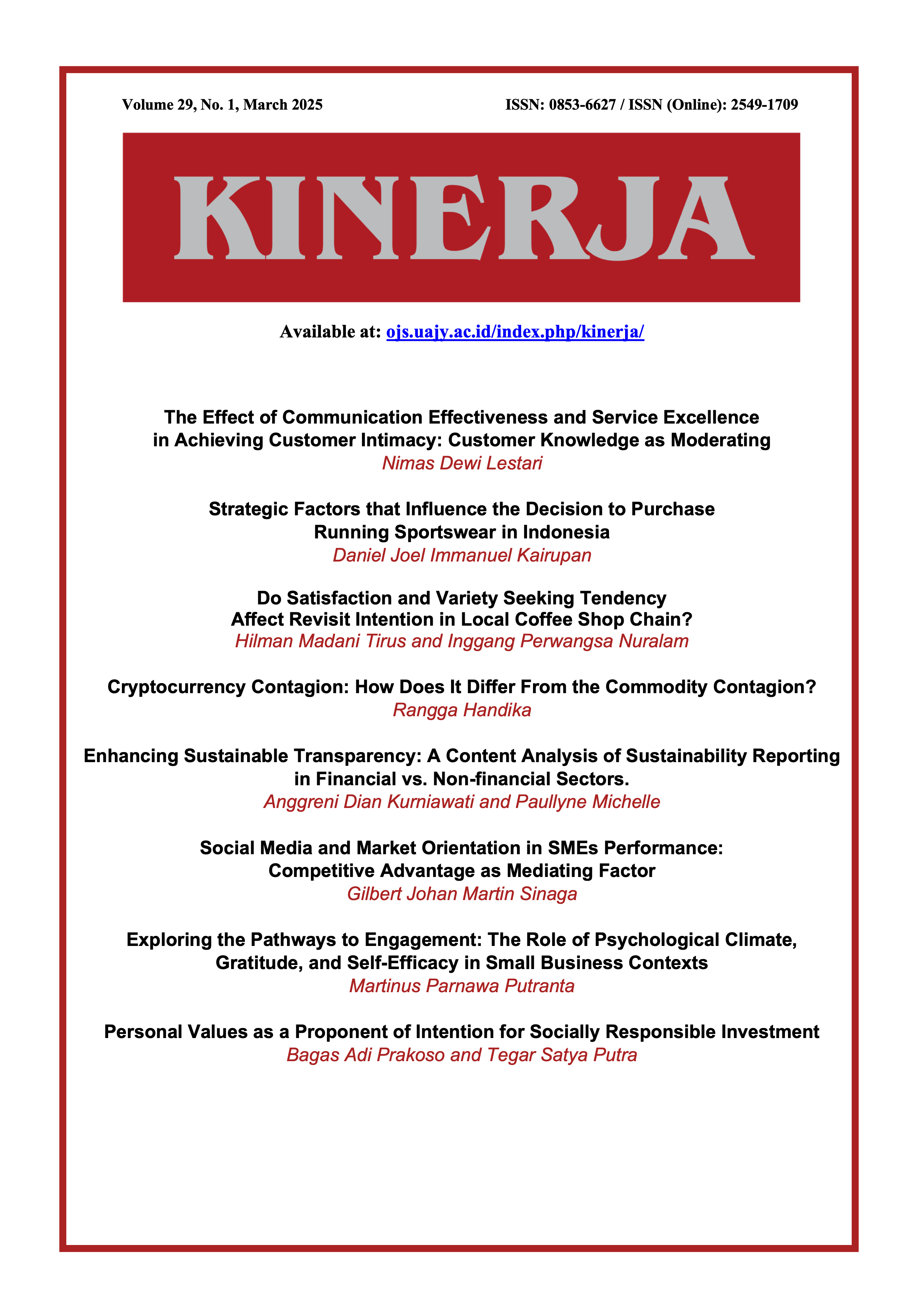The Effect of Communication Effectiveness and Service Excellence in Achieving Customer Intimacy: Customer Knowledge as Moderating
DOI:
https://doi.org/10.24002/kinerja.v29i1.8663Keywords:
communication effectiveness, service excellence, customer intimacy, customer knowledgeAbstract
Customer intimacy is a business strategy that is implemented by giving high attention to the strategy of marketing relationships. In the long term, customer intimacy can positively impact a company. There are several ways to increase customer intimacy. Some of them are through effective communication, service excellence, and customer knowledge. Bank Syariah Indonesia is one of the banks that implement a service excellence strategy for customers, and even Bank Syariah Indonesia has won awards in the field of service excellence. The purpose of this survey is to determine the effect of effective communication and service excellence in increasing customer intimacy through the moderating of variable customer knowledge. This research uses quantitative methods. Sampling in this study used snowball sampling techniques, with a total sample of 100 customers. The results of this study indicate that communication effectiveness and service excellence have a significant effect on increasing customer intimacy, and communication effectiveness has no effect on customer intimacy with variable moderation customer knowledge, and service excellence has a significant positive effect on increasing customer intimacy with moderation variable customer knowledge. This research is expected to provide benefits for various parties in improving the quality of interaction between banks and customers, to create closer and more sustainable relationships, emphasizing the need to implement service excellence to create a positive customer experience and increase loyalty, and optimizing the use of customer knowledge to adjust service and communication strategies to suit customer needs better.
References
Åkesson, T., 2022. Subgroups of customer intimacy and their influence on customer loyalty A structural equation modeling approach. Blekinge Institute of Technology.
Al-Arif, M. N. R., 2019. Dasar-Dasar Pemasaran Bank Syariah. Bandung: Alfabeta.
Al-Msallam, S., 2015. The relationship between customer satisfaction and customer loyalty in the banking sector in Syria. Journal of Marketing and Consumer Research, 7(9), pp.27–35.
Anantadjaya, S., Nawangwulan, I., Pramesty, A. and Gunawan, A., 2015. Measuring customers’ intimacy: Evidence from Indonesian service-based companies. Ekonomika, 61(2), pp.11–28. Available at: https://doi.org/10.5937/ekonomika1502011a
Aprilliantoni, A., 2022. Service quality dynamics and bank customer loyalty: Study of PT Bank Central Asia Tbk Bintaro. Accounthink : Journal of Accounting and Finance, 7(01), pp.96–111.
Atmadjati, A., 2018. Layanan Prima dalam Praktik Saat Ini. Yogyakarta: Deepublish.
Azizah, L. A., 2023. Strategy to improve service quality through banking service digitization. International Journal of Accounting, Management and Economics, 1(1), pp.81–88.
Bahreinizad, M., Esmaeilpour, M., and Moradi, K., 2020. Brand communications and customer equity: the mediating role of brand knowledge and word of mouth ads. Romanian Economic and Business Review, 15(4), pp.90–103.
Bank Syariah Indonesia (BSI, 2021. BSI Boyong 5 Penghargaan dari InfoBank Banking Service Excellence Award 2021. Available at: https://www.bankbsi.co.id/news-update/berita/bsi-boyong-5-penghargaan-dari-infobank-banking-service-excellence-award-2021
Binowo, M., Worang, F. G. and Arie, F. V., 2023. The effect of service quality elements on customer satisfaction at BRI Unit Unsrat Manado. Jurnal EMBA : Jurnal Riset Ekonomi, Manajemen, Bisnis Dan Akuntansi, 11(1), pp.645–655. Available at: https://doi.org/10.35794/emba.v11i1.45999
Bonalumi, F., Scott-Phillips, T., Tacha, J. and Heintz, C., 2020. Commitment and communication: Are we committed to what we mean, or what we say? Language and Cognition, 12(2), pp.360–384. Available at: https://doi.org/10.1017/langcog.2020.2
Caussat, P., 2021. Competitive advantages in a hostile, regulated environment: Four multinational banks in India. Management International Review, 61(6), pp.831-879. Available at: https://doi.org/10.1007/s11575-021-00459-6
Ellitan, L., Sugiyanto, S. A. and Risdwiyanto, A., 2022. Increasing repurchase intention through experiential marketing, service quality, and customer satisfaction. Jurnal Maksipreneur: Manajemen, Koperasi, Dan Entrepreneurship, 12(1), p.164. Available at: https://doi.org/10.30588/jmp.v12i1.1022
Fernandez, A. P. P., 2020. Kontribusi efektivitas komunikasi untuk meningkatkan kepercayaan nasabah. Jurnal Ekonomedia, 09(02), pp.1–20.
Ganefi, H. S., Ermawati, W. J. and Hakim, D. B., 2021. Market structure, income diversity, and stability: Empirical study of banking industry Indonesia. Jurnal Keuangan Dan Perbankan, 25(3), pp.701–716. Available at: https://doi.org/10.26905/jkdp.v25i3.5887
Gil-Gomez, H., Guerola-Navarro, V., Oltra-Badenes, R. and Lozano-Quilis, J. A., 2020. Customer relationship management: digital transformation and sustainable business model innovation. Economic Research-Ekonomska Istrazivanja, 33(1), pp.2733–2750. Available at: https://doi.org/10.1080/1331677X.2019.1676283
Gonu, E., Agyei, P.M., Richard, O.K. and Asare-Larbi, M., 2023. Customer orientation, service quality and customer satisfaction interplay in the banking sector: An emerging market perspective. Cogent Business & Management, 10(1), p.2163797. Available at: https://doi.org/10.1080/23311975.2022.2163797
Guerola-Navarro, V., Gil-Gomez, H., Oltra-Badenes, R. and Soto-Acosta, P., 2024. Customer relationship management and its impact on entrepreneurial marketing: A literature review. International Entrepreneurship and Management Journal, 20(2), pp.507-547. Available at: https://doi.org/10.1007/s11365-022-00800-x
Haider, S. A. and Kayani, U. N., 2021. The impact of customer knowledge management capability on project performance-mediating role of strategic agility. Journal of Knowledge Management, 25(2), pp.298–312. Available at: https://doi.org/10.1108/JKM-01-2020-0026
Hoffman, N.P., 2001. The theory of customer intimacy: towards an understanding of relationship marketing in a professional service setting. The University of Alabama. Available at: https://www.proquest.com/openview/3ff4c135c2f9e212c8c1702c9e265620/1?pq-origsite=gscholar&cbl=18750&diss=y
Jannah, M., Darmini, D. and Rochmayanti, D., 2017. Komunikasi efektif berperan dalam meningkatkan kepuasan pasien di instalasi radiologi. Link, 13(2), pp.28-33. Available at: https://doi.org/10.31983/link.v13i2.2924
Joseph, K. O., Omotayo, A., Mosunmola, A. and Taiye, B., 2016. Marketing concept and the satisfaction of consumer needs : the nigerian consumer’s experience. Researchjournali’s Journal of Marketing, 4(1), pp.1–15.
Kabue, H.W., 2021. Enhancing customer retention: the role of customer knowledge management. International Journal of Business Management and Commerce, 6(1), pp.1-11.
Karliadi, A. and Erawati, D., 2023. The Influence of Communication and Problem Handling Customer Satisfaction in Using Call Center Services (Study on Conventional Banks in the City of Palangka Raya). JAMBURA: Jurnal Ilmiah Manajemen dan Bisnis, 6(2), pp.536-544. Available at: https://doi.org/10.37479/jimb.v6i2.19580
Khan, T. N., 2016. Islamic banks service innovation quality: Conceptual model. Al-Iqtishad: Journal of Islamic Economics, 8(2), pp.287–306. Available at: https://doi.org/10.15408/aiq.v8i2.3161
Khodakarami, F. and Chan, Y. E., 2014. exploring the role of customer relationship management (CRM) systems in customer knowledge creation. Information & Management, 51(1), 27–42. Available at: https://doi.org/10.1016/j.im.2013.09.001
Kotler, P., Armstrong, & Garry., 2008. Prinsip-Prinsip Pemasaran. Jakarta: Erlangga.
Krishnaraj, R., 2022. A review on customer intimacy and its theories. EasyChair Preprint, p.8185.
Kuswandi, D., Ratih, S.W.W., Sahara, R., Widiarsih, W. and Gunawan, B., 2022. The Development of the Banking Industry in the Digital Era in Indonesia. Jurnal Ilmiah Manajemen, Ekonomi, & Akuntansi (MEA), 6(3), pp.878-890. Available at: https://doi.org/10.31955/mea.v6i3.2502
Lemon, K. N. and Verhoef, P. C., 2016. Understanding customer experience throughout the customer journey. Journal of Marketing, 80(6), 69–96. Available at: https://doi.org/10.1509/jm.15.0420
Marta, M. S., Hurriyati, R. and Dewi, P., 2021. The role of Market Orientation, Innovation Capability, and Learning Orientation. RELEVANCE: Journal of Management and Bussines, 4(2), pp.95–109.
Mas, S. R. and Haris, P. I., 2020. Komunikasi dalam Organisasi (Teori dan Aplikasi). Gorontalo: UNG Press Gorontalo.
Migdadi, M. M., 2021. Knowledge management, customer relationship management and innovation capabilities. Journal of Business and Industrial Marketing, 36(1), pp.111–124. Available at: https://doi.org/10.1108/JBIM-12-2019-0504
Moghavvemi, S., Lee, S. T. and Lee, S. P., 2018. Perceived overall service quality and customer satisfaction: A comparative analysis between local and foreign banks in Malaysia. International Journal of Bank Marketing, 36(5), pp.908–930. Available at: https://doi.org/10.1108/IJBM-06-2017-0114
Morgan, R. M. and Hunt, S. D., 1994. The commitment-trust theory of relationship marketing. Journal of Marketing, 58(3), p.20. Available at: https://doi.org/10.2307/1252308
Mukarom, Z. and Laksana, M. W., 2015. Manajemen Pelayanan Publik. Bandung: Pustaka Setia.
Nafiah, N., 2021. Pengaruh customer intimacy, promosi, dan citra merek islam terhadap loyalitas nasabah Bank Syariah Indonesia KCP Godean 3 dengan kepuasan sebagai variabel intervening. Jurnal Transformatif, 5(2), pp.177–190.
Naini, N. F., Sugeng Santoso, Andriani, T. S., Claudia, U. G. and Nurfadillah, 2022. The effect of product quality, service quality, customer satisfaction on customer loyalty. Journal of Consumer Sciences, 7(1), pp.34–50. Available at: https://doi.org/10.29244/jcs.7.1.34-50
Nitisusastro, M., 2012. Perilaku Konsumen dalam Prespektif Kewirausahaan. Bandung: Alfabeta.
Nora, L., 2019a. Testing customer’s knowledge on customer intimacy and its impact on repurchase intention. VINE Journal of Information and Knowledge Management Systems, 49(4), pp.594–608. Available at: https://doi.org/10.1108/VJIKMS-03-2019-0041
Nora, L., 2019b. Trust, commitment, and customer knowledge: Clarifying relational commitments and linking them to repurchasing intentions. Management Decision, 57(11Nora, L. (2019). Trust, commitment, and customer knowledge: Clarifying relational commitments and linking them to repurchasing intentions. Management Decision, 57(11), pp.3134–3158. https://doi.org/10.1108/MD-10-2017-0923), 3134–3158. Available at: https://doi.org/10.1108/MD-10-2017-0923
Novita, Y., Setiawan, A. and Al-Umar, A. U. A., 2021. Kepuasan sebagai mediasi pengaruh service quality dan customer intimacy teradap loyalitas nasabah. Jurnal Perspektif Ekonomi Darussalam, 7(2), pp.1–18.
Nurdiani, T.W. and Alie, R.M., 2023. Build a Service Excellence Culture of Pleasure to Customers. EJOIN: Jurnal Pengabdian Masyarakat, 1(1), pp.29-34.
Nurrahmawati, R., Budiharti, N. and Adriantantri, E., 2021. Analisa service excellent (pelayanan prima) pada pelayanan posyandu Desa Sidodadi Lawang. Jurnal Valtech, 4(2), pp.210-216. Available at: https://ejournal.itn.ac.id/index.php/valtech/article/view/3860
Octrina, F. and Setiawati, R., 2019. Competitiveness of Indonesian banking industry based on commercial bank business group: Panzar Rosse Model. Jurnal Perspektif Pembiayaan Dan Pembangunan Daerah, 7(1), pp.37–48. Available at: https://doi.org/10.22437/ppd.v7i1.7475
Osei, G., 2017. Customer intimacy adoption and its impact on organisational performance. Journal of Research in Marketing, 8(1), pp.600. Available at: https://doi.org/10.17722/jorm.v8i1.197
Parajuli, S., Paudel, U.R. and Devkota, N., 2020. Banking communications: A perceptual study of customer relations. South Asian Journal of Social Studies and Economics, 8(3), pp.23-34. Available at: https://doi.org/10.9734/sajsse/2020/v8i330212
Pula, F., 2022. Co-creating value and its impact on customer satisfaction and customer loyalty: a banking sector perspective. Journal of Governance and Regulation, 11(4), pp.179–190. Available at: https://doi.org/10.22495/jgrv11i4art17
Putri, S. E., 2022. The effect of mediation on consumer involvement and intimacy on trust and loyalty at bank syariah Indonesia. Proceedings of the 7th Sriwijaya Economics, Accounting, and Business Conference (SEABC 2021), 647(Seabc 2021), 188–193. Available at: https://doi.org/10.2991/aebmr.k.220304.025
Raguž, I. V., Zekan, S. B. and Peronja, I., 2017. Knowledge as a source of competitive advantage in knowledge based companies. DIEM: Dubrovnik International Economic Meeting, 3(1), pp.533–544. Available at: https://doi.org/https://hrcak.srce.hr/187409
Rane, N. L., Achari, A. and Choudhary, S. P., 2023. Enhancing customer loyalty through quality of service: Effective strategies to improve customer satisfaction, experience, relationship, and engagement. International Research Journal of Modernization in Engineering Technology and Science, 05(05), pp.427–452. Available at: https://doi.org/10.56726/irjmets38104
Ratnawili, Fitri, M. A. and Arini, E., 2021. Pengaruh service excellence, customer experience dan brand trust terhadap customer loyalty (Studi kasus pengguna jasa Grab di Kota Bengkulu). Jurnal Ilmiah Akuntansi, Manajemen Dan Ekonomi Islam (JAM-EKIS), 4(2), pp.394–407.
Reavis, M. R., 2021. Banking class engagement and the special nature of banks. Journal of Instructional Pedagogies, 25, 1–8.
Rhamdhan, I. M. and Riptiono, S., 2023. The effects of religiosity, trust, intimacy toward commitment and customer loyalty at shariah microfinance. Jurnal Aplikasi Bisnis Dan Manajemen, 9(2), pp.492–500. Available at: https://doi.org/10.17358/jabm.9.2.492
Rumiyati, R. and Syafarudin, A., 2021. The influence of service quality, marketing mix, on bank customer satisfaction in the era covid-19. Ilomata International Journal of Tax and Accounting, 2(1), pp.84–96. Available at: https://doi.org/10.52728/ijtc.v2i1.206
Saputra, S., 2019. The Effect of Customer Relationship Management (CRM) on Bank Customer Loyalty through Satisfaction as Mediating Variable: Evidence in Batam, Indonesia. Advances in Social Science, Education and Humanities Research, 306, 146–151. Available at: https://doi.org/10.2991/isseh-18.2019.34
Setiadi, 2008. Perilaku Konsumen: Konsep dan Implikasi Strategi dan Penelitian Pemasaran. Jakarta: Graha Ilmu.
Sharma, N. and Patterson, P. G., 1999. The impact of communication effectiveness and service quality on relationship commitment in consumer, professional services. Journal of Services Marketing, 13(2), pp.151–170. Available at: https://doi.org/10.1108/08876049910266059
Shrestha, S., Parajuli, S. and Paudel, U. R., 2019. Communication in banking sector: A systematic review. Quest Journal of Management and Social Sciences, 1(2), pp.272–284. Available at: https://doi.org/10.3126/qjmss.v1i2.27445
Sugiarto, S. and Octaviana, V., 2021. Service quality (SERVQUAL) dimensions on customer satisfaction: empirical evidence from bank study. Golden Ratio of Marketing and Applied Psychology of Business, 1(2), pp.93–106. Available at: https://doi.org/10.52970/grmapb.v1i2.103
Suwarman, U., 2002. Perilaku Konsumen (Teori dan Penerapannya dalam Pemasaran). Bogor: Ghalia Indonesia.
Syahlevi, T., Tanaamah, A.R. and Sitokdana, M.N., 2018. Perancangan strategi customer relationship marketing menggunakan pendekatan customer intimacy strategi dalam rangka membangun keintiman dengan pelanggan (Studi kasus: Supplier bless fashion salatiga & projects. co. id project and digital product marketplac. SEMNASTEKNOMEDIA ONLINE, 6(1), pp.2-6.
Umer, M., 2016. Customer’s perception on service quality dimensions in banking sector of Pakistan. Industrial Engineering Letters, 6(6), pp.1-15.
Venter, E., 2019. Challenges for meaningful interpersonal communication in a digital era. HTS: Theological studies, 75(1), pp.1-6. Available at: https://doi.org/10.4102/hts.v75i1.5339
Vitram, K. L., Rasa, M. I. and Harto, S., 2023. Customer intimacy, customers experience, customer satisfaction, customer bonding dan customer value dalam loyalitas nasabah di bank syariah. Jurnal Ekonomi Bisnis, 22(1), pp.44–54. Available at: https://doi.org/10.32722/eb.v22i1.5765
Widiantono, A. and Sejati, P., 2022. Implementation of knowledge management on customer relationship management system, a literature review. Proceedings of the First Mandalika International Multi-Conference on Science and Engineering 2022, MIMSE 2022 (Informatics and Computer Science) (MIMSE-I-C-2022), 55–65. Available at: https://doi.org/10.2991/978-94-6463-084-8_7
Widijanto, R. S. R. and Rachmat, B., 2019. Effect of bank commitment, bank communication and handling customer complaint on customer loyalty through customer satisfaction at PT Bank Central Asia Tbk of Mojopahit Mojokerto sub-branch office. International Journal of Multicultural and Multireligious Understanding, 6(3), p.49. Available at: https://doi.org/10.18415/ijmmu.v6i2.756
Wulandari, D., 2022. Customer satisfaction as a priority in excellent banking services. KINERJA: Jurnal Manajemen Organisasi dan Industri, 1(1), pp.27-34.
Xie, K., Wu, Y., Xiao, J. and Hu, Q., 2016. Value co-creation between firms and customers: The role of big data-based cooperative assets. Information & Management, 53(8), pp.1034-1048. Available at: https://doi.org/10.1016/j.im.2016.06.003
Yi, H.T., Lee, M. and Park, K., 2022. Service orientation and customer performance: Triad perspectives of sales managers, sales employees, and customers. Behavioral Sciences, 12(10), p.373. Available at: https://doi.org/10.3390/bs12100373
Yuniarti, V. S., 2015. Perilaku Konsumen Teori dan Praktik. Pustaka Setia.
Zouari, G. and Abdelhedi, M., 2021. Customer satisfaction in the digital era: evidence from Islamic banking. Journal of Innovation and Entrepreneurship, 10, pp.1-18. Available at: https://doi.org/10.1186/s13731-021-00151-x.
Downloads
Published
Issue
Section
License
Copyright (c) 2025 Nimas Dewi Lestari

This work is licensed under a Creative Commons Attribution 4.0 International License.















